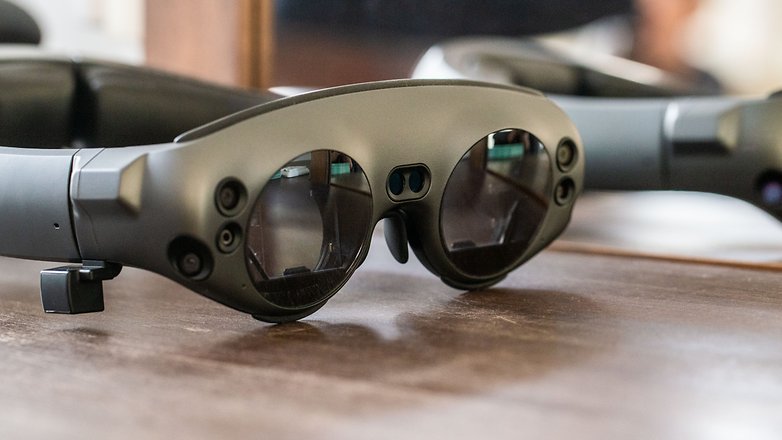I tried Magic Leap and didn't want to come down


Is magic real? For a few years, the name Magic Leap was scoffed at by skeptics in the AR/VR community, but now the mythical device is out in the world. Well, seeing is believing, so when we had an opportunity to put it to the test, we couldn't pass the chance to describe to you what lies behind the lens of the hologram hype machine.
Magic Leap the company is a startup that has historically been big on promises but short on proofs, a combination of confidence and secrecy that kept it going for almost 7 years without a working product. But whatever they had going was enough to impress the big tech giants, and when Google led a $542 million investment into Magic Leap back in 2014, it started to be taken more seriously. Now we see the fruit of this gamble.

The Magic Leap One Creator Edition is a mixed-reality headset with a jaw-dropping $2,300 price tag, but as the name suggests, it's aimed primarily at other businesses and developers who want to use it to make content and apps for the platform. Despite this, Magic Leap CEO Rony Abovitz has stated that it’s a “full-blown, working consumer-grade product,” not a prototype. It's meant to be a step towards a mixed-reality revolution...Magic Leap claims that this technology will replace smartphones, computers and similar gadgets in everyday life.
At TechCrunch Disrupt Berlin, we were invited by Nomtek, the only European developer for Magic Leap, to try out the device. So let's see what they're working with.
Watch us take Magic Leap One for a spin and chat with Piotr from Nomtek in the video below:
Comfortable, if not exactly stylish
The Magic Leap One headset is basically a pair of goggles called 'Lightwear' plugged into a small computer about the size and shape of one of those old-school portable compact disc players, the 'Lightpack', plus a controller for interaction. The headset itself eschews the visor-like style popular with VR headsets and its established competitor in the mixed reality space, Microsoft's Hololens.

The round goggles are more cyberpunk than Star Trek, and your personal preference may be a matter of taste, but to wear, it's easily the most comfortable headsets I've ever tried, with a lighter, more natural fit than the Hololens or VR headsets like the Oculus Rift. It's a simple adjustable plastic loop that rests kind of high on the back of your head and doesn't feel face-heavy.
The headset itself has integrated inside-out cameras for position tracking and an audio jack and speakers. Bluetooth and wireless antennas are also included for connectivity. The controller isn't anything unusual for its type. Anyone familiar, with say, an Oculus Go or Daydream controller will find it similar, but it is fully tracked, so it can act as a virtual hand rather than just a glorified laser pointer.

The reason why the Magic Leap is so comfortable is that the heavy lifting is offloaded onto the Lightpack (Nvidia Tegra X2, 8GB RAM, 128GB storage), which sits quite unobtrusively in a pocket or on a strap, which is how I wore it in our demo. It can apparently last around 3 hrs away from the charging station.
The magic happens
Piotr from Nomtek is a busy man, hosting back to back demos for two days in Berlin. But he's clearly a believer, and the spark in his eyes when we discuss the technology is unmistakably genuine. He loads up some specific demos for me to try: because yet-to-be-announced Nomtek projects are loaded onto the device, I don't get to see much of the Lumin OS UI and menus.
What we do get a glimpse of however is the mapping process that must take place before the magic. The device needs to scan your surroundings after being activated, to know where to place virtual objects. This can take up to a couple of minutes, and unfortunately, due to harsh light from the low-hanging sun beaming into the room, we had a few false starts. Clearly, this isn't a device ready for outdoor use, and needs pretty specific conditions to perform optimally.

The 50-degree diagonal field of view from the Magic Leap One is both very impressive (it's a much wider than the Hololens) and a sober reminder of the technology's current limitations. All the virtual content is only visible in a big invisible 'box' in front of you, which can be very distracting as objects clip or are cut off at the edges when you're moving your gaze.
Another visual quirk of using a device like this is the fact that you'll sometimes see flecks of color bleeding around the edges of your vision, lending a psychedelic tone to the whole experience. Objects appear as ethereal holograms but have a quasi-solid look in that yes, they can block real objects from your vision, although the lack of realistic shadow is also a tell that developers should work to fix.

Once the demos actually get going though, it's hard not feel immersed. The first demo I tried was an AR version of Angry Birds in which the controller acted as a slingshot to propel the aggressive avians towards a stack of blocks that appeared on the floor in front of me. Simple enough, and fun, but what I liked here was the balance of the real and virtual worlds.
Immersive VR games are very isolating and even many AR games need a lot of concentration, but using Magic Leap felt natural, and while I must have still looked like a madman waving at nothing, I enjoyed being fully aware of everyone around me, being able to carry out conversations and sip a coffee while trying it out.

VR and AR is becoming very popular with movers, decorators and furniture sellers because of the potential to try out different looks and layouts in virtual space. The WayFair app for Magic Leap allowed us to seamlessly place catalog objects in the actual room, change sizes and colors, rotate and so on.
Finally, Dr. Grordborts Invaders, a wacky steampunk shooter that transforms the controller into a blaster, showed me how an action game, even in mixed reality, could immerse me enough that I lost track of my real life surroundings and companions somewhat. Here I could see the potential for really fun, more complex games on the Magic Leap, but it the isolation one gets from VR is also a factor here...I was alone in my hallucination, but some kind of multiplayer function would make this infinitely more fun.
Not quite a leap, but a step in the right direction
Despite imperfections such as limited field of view and flickering colors, the illusions of the Magic Leap are enchanting and I put it down with a heavy heart. Having said that, to break the spell, the price tag alone would make me drop it like a hot stone.
What the Magic Leap One does right now more than anything is stimulate the imagination
Magic Leap is thrilling to try and it may be the best augmented reality/mixed reality device out in the open right now. But much of it is still untapped potential, more a fantasy in my own head than anything possible in reality today. There is still only limited use, and visual and comfort issues need to be refined before it's something everyone will want. To buy one for personal entertainment now would just be an incredibly expensive toy.
What the Magic Leap One does right now more than anything is stimulate the imagination, and that's a good thing for a developer-oriented product, because it's these content creators like Nomtek that will be making the experiences that will make such a device desirable. Much like the first smartphones were transformed into the center of personal computing thanks to apps.

Talking to Piotr from Nomtek after our demo, it's clear that he also sees it this way, making repeated references to the first iPhone. As we discuss the potential applications his company is working on, I'm surprised to hear not just mention of industrial use, which is already adopting VR/AR/MR in a big way, but also personal entertainment and sports.
Another important point we agreed on: some way of sharing the mixed reality experience with others can't come soon enough, both through livestreaming (so we can finally show, and not simply tell, what the experience is like), and shared experiences/multiplayer gaming, because what's the point of augmenting the real world if we can't involve the people around us? Happily blasting away in the game demo, it's disappointing to meet the bemused gaze of people around you who can't see what's happening.

Piotr envisages the 'Internet 3D', a new evolution of the information age where we leave our computers and smartphones behind, and use holographic lenses instead of screens, swiping and pointing through the air at semi-real shared visions. It's an exciting vision, both futuristic but also more 'natural' than staring at screens and tapping on keys, something that dovetails very well with advances in voice control, too.
But alas, we're not there yet. As delightful as the Magic Leap is to try for free, there are still many issues, both technical and cultural, to be worked out before we're all in the Internet 3D. But the foundation is being laid for it. Fittingly, the Magic Leap One is an illusion of illusions, slowly coalescing into the real. I'm sure we'll all be meeting each other in this Internet 3D one day, using some slimmer, more efficient version of Magic Leap, or something inspired by it. But look forward to celebrating quite a few birthdays before then.
What do you think of the potential of mixed reality? Is Magic Leap One a step in the right direction?




















I find it very difficult to trust a company that hyped a product so hard for so long but fell short in what they delivered.
when Google invested $542 billion. Lol Ahem, no...
Not to mention Palmer lucky's review branding this over hyped vapourware 'tragic heap' is far more fitting!
Pretty sure Google did NOT invest $542 billion into Magic Leap back in 2014.
Yikes, a typo of 'm' to 'b' briefly put us in a very different economic world. Thank you and corrected.